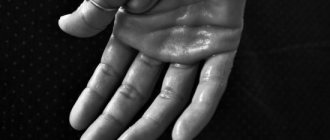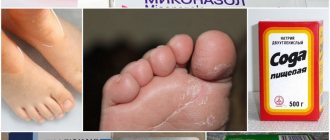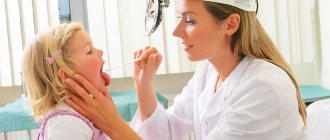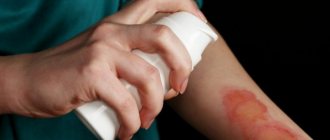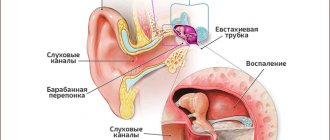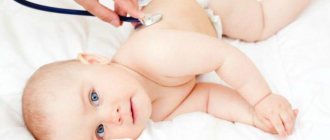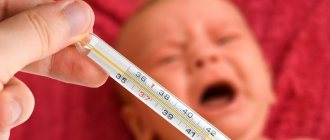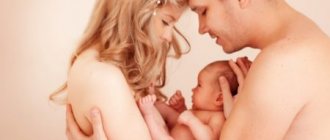Any disease brings suffering, and psoriasis - twice as much. Especially if a child is suffering. Psoriasis in children is not a new phenomenon and, unfortunately, very common. The disease can be diagnosed at any age - both in infants and in younger schoolchildren. In recent years, the second category of children suffers from the disease more and more often. The disease usually manifests itself in a chronic form. When the first signs appear, drastic measures should be taken immediately, and in combination with the most effective treatment methods. Do not forget about prevention during remission and always be on guard. Psoriasis is insidious and dangerous. But we will win. The main trump card in the fight against it is time. The sooner you start treatment, the more stable the remission will be and the longer your baby will rest.
Childhood and adolescent psoriasis: characteristics of the disease
Chronic dermatosis of a non-infectious form, or psoriasis in a child, is a pathology without gender and age restrictions. Symptoms are associated with changes in the skin and nail plates. When seeing classic signs in a child, they are most often mistaken for some form of dermatitis. The initial diagnosis, accompanied by a specific treatment regimen, is not confirmed after some time, when the disease begins to progress and take on more obvious forms. From psoriasis, a child suffers not so much from pain as from somatic and psychological discomfort. After all, the pathology manifests itself not at all aesthetically. Children are embarrassed by red, rough spots, especially if they are in visible places. You need to treat psoriasis right away - make an appointment with a specialized specialist and not waste time experimenting with unconventional methods.
Prevention
Sound sleep is very important for a child's health
If you are thinking about how to reduce the likelihood of psoriasis in your baby, then you need to follow simple rules.
- You should not use aggressive preparations to care for your child’s skin, as well as hard washcloths when taking water treatments.
- When choosing medications, carefully study the instructions and possible side effects.
- Do everything to relieve your baby of possible stress as much as possible.
- Do not allow your little one to remain in direct sunlight for long periods of time.
- Buy clothes exclusively from natural materials; skin contact with synthetics is undesirable.
- It is important that the child has proper nutrition and healthy sleep.
- Increase your baby’s immunity, in particular with hardening procedures, physical activity and vitamin therapy.
- Take care to develop a sense of self-preservation in the child; he should avoid injury to the skin, cuts and even minimal burns.
Now you know what psoriasis is in children and the causes of this condition. Remember the need for timely diagnosis and proper treatment. Do not forget that psoriasis is fraught with the development of serious complications that can greatly ruin a child’s life. Don’t be alarmed if your little one has been diagnosed with psoriasis - this is not a death sentence.
Classic signs of psoriasis in children
Parents whose children have been diagnosed with this disease do not believe in it in most cases. After all, pathologists have a fairly serious history. It takes a chronic form and is practically incurable. Skin cells begin to divide more intensely - and this results in the appearance of rashes, flaky itchy or weeping plaques and ulcers located above the skin level.
And although the signs are very obvious and characteristic, only a dermatologist can make an accurate diagnosis. Some forms of the disease resemble diaper dermatitis and even candidiasis in their manifestations. Their treatment regimens are different.
Statistics
Of the 100 children who were initially diagnosed with dermatosis or dermatitis, 15 cases had a form of psoriasis. In approximately 75%, the first manifestations of the disease begin in children under 5 years of age. This pathology is merciless even to infants.
Video: Fragment of the program “Live Healthy!” Psoriasis: symptoms and treatment
Signs
Initially, the signs of psoriasis development are similar to many other, and not necessarily skin, diseases. However, it is still worth highlighting them:
- general weakness of the body;
- feeling tired;
- depressed state;
- prickly heat;
- nettle rash;
- dermatitis;
- skin soreness;
- constant itching;
When rashes appear, they can be distinguished from rashes accompanying other dermatoses by characteristic external signs:
- their shape is round;
- edges are clearly defined;
- the color is either pink or reddish;
- scales covering grayish-white plaques.
Reasons for the development of pathology
Modern doctors make many discoveries, millions of studies are conducted every day. However, the exact reasons for the development of the disease in children are not yet known to science. There are several theories about the occurrence of the disease, including autoimmune.
The risk definitely increases, and significantly, if one of the biological parents suffers from the disease. The chances of hereditary transition are one in four. If both parents have the disease, the risk of genetic connections increases to 60-70%.
But heredity and genetics are not the only factors that play a role in psoriasis; external causes and factors also play a certain role. Provocateurs of pathology are infections, stress, skin injuries, fear, and diseases of internal organs.
Psoriasis worsens during critical periods in children's age cycle - nursery, kindergarten, school, and during peak psycho-emotional stress and stressful situations - public speaking, exams, important tests.
Causes
In recent years, cases of inflammation on the skin in newborns, infants, and preschool children have become more frequent. It is not always possible for a pediatrician to distinguish psoriasis rashes from other types of dermatitis, so if skin problems arise, it is better to contact a specialist. He is a pediatric dermatologist.
The question regarding the factors causing psoriasis has not yet been fully studied.
Currently, there are several scientifically proven reasons:
- Heredity. If one or both parents have psoriasis, the risk of developing pathology in the child is estimated at 8-15% and 40-60%, respectively.
- Serious metabolic disorders. They can be caused by long-term vitamin deficiency, for example.
- Infection with worms causes severe intoxication of the body, which can lead to skin rashes.
- Incorrect functioning of the hormonal system.
- Nervous system disorders. Severe stress, a major change in life, a conflict situation in the family and other negative factors can give impetus to the development of psoriasis in a child. Psychosomatics ranks second in the frequency of provoking pathology in children (heredity comes first).
- Previous infectious diseases can also cause the development of skin problems. Moreover, the provocateur is often not only the flu, measles, chicken pox and other dangerous diseases, but also the common cold.
- Dysfunction of internal organs (for example, if the liver cannot cope with the removal of toxins normally, there is a risk of developing psoriasis).
- Skin injuries are another serious trigger.
There are other indirect reasons that can trigger the development of the disease in a child’s body. These include: allergies, dry indoor air, rare walks outside, improper hygiene, vaccination, etc.
What does psoriasis look like in children?
In infancy, the disease is similar to thrush, just diaper rash, or at most eczema. The top layer of skin is mottled with areas with borders of rich pink color. Dotted scales are detected.
Older children begin to actively scratch the reddened areas, a specific rash appears, nodules appear, another name is papules, with gray scales. These “attributes” of psoriasis gradually increase and begin to combine with each other. The surface of the papules may become wet and have microcracks. Because of this feature, the pathology is dangerous due to infections.
Video: what the initial signs of psoriasis look like in children
How and with what to treat psoriasis
No matter how hard you try, psoriasis cannot be cured forever. The disease can be stopped and remission will probably occur. You will think that you have been cured, but after some time everything will happen again. Diet plays an important role in the treatment of psoriasis. You should avoid eating fats and sweets. It is necessary to exclude food of animal origin. Recommended:
- fish;
- poultry meat;
- greens: dill, parsley, salads;
- porridge;
- dairy products;
- vitamins.
Treatment for psoriasis is prescribed only by a dermatologist. To combat the disease, it is recommended to use:
- Medicines: immunosuppressants, retinoids.
- Moisturizing the skin with baths and creams.
- Non-hormonal ointments.
- Phototherapy is prescribed to children with caution.
- Puva therapy - the use of photochemistry - is under the strict supervision of doctors.
- Treatment with folk remedies.
- Vitamin courses.
Find out more about how to treat psoriasis on the head and body.
On the head
If symptoms of the disease appear on the head, it is recommended:
- lubricate the skin with fresh celandine juice, and on top with fish oil;
- apply essential oils of bergamot, geranium;
- rub plaques with wet oatmeal;
- drink sea buckthorn oil one spoon a day;
- make lotions from sauerkraut juice;
- lubricate plaques with baby cream;
- take retinoids.
On the elbows
Birch tar is great for treating skin on the elbows. It is applied to the affected areas, ranging from ten minutes to forty, then washed off with soap. Due to the strong smell, it is better to carry out the procedure in the evening. The use of machine grease gives good results. It is spread in a thick layer and left for 20 to 40 minutes. Wash off with tar soap.
On the body
If psoriasis appears on the body, it is best to take baths. They can be with sea salt, string, chamomile. Baking soda baths help. One procedure requires 900 grams of product. They are done every other day for two months. Treatment of affected areas with sea buckthorn oil gives good results. It disinfects, heals and dries the skin.
On the face
To treat facial lesions, you can apply a paste of baking soda and water and leave for several hours. Rubbing essential oils of rose and jasmine helps. Egg ointment works well when applied at night. According to the recipe, mix:
- 3 yolks;
- 2 large spoons of laundry soap;
- 200 g chicken fat;
- 2 fly in the ointment;
- fir oil and soda, a teaspoon;
- 2 tablespoons of medical bile.
Therapeutic therapy, which is aimed at eliminating the signs of psoriasis in a young child, can be carried out at home or in a hospital. The last option is the most optimal if the patient has a progressive stage of the disease.
It is necessary to find out how to treat psoriasis from a dermatologist who monitors the child’s condition. He may suggest a course of therapy based on the following medications:
- Sedative and desensitizing. You will need to take a calcium gluconate solution (5%) or a calcium chloride solution (10%). This should be done 3 times a day. The drug is taken in a teaspoon or tablespoon, depending on the doctor’s recommendation. Intramuscular injections based on calcium gluconate solution (10%) are also prescribed. It is necessary to undergo at least 10 procedures;
- Antihistamines. They help get rid of severe itching. These medications are taken in courses, each lasting up to 10 days; Vitamins. Typically, children are prescribed ascorbic acid, which should be taken 3 times a day up to 0.1 g. A solution of pyridoxine (up to 5%) is also used. They give injections with it. Administration of vitamin B12 intramuscularly is indicated. Vitamin B15 and potassium orotate are taken internally;
- Pyrogenic. They are necessary to stimulate the body's defense mechanisms. With their help, it is possible to normalize vascular permeability and eliminate the mitotic activity of skin layers. On the recommendation of the attending physician, children are treated with a pyrogenic drug such as Pyrogenal. To achieve optimal results, about 8 courses of injections are required.
Traditional medicine suggests that children diagnosed with psoriasis undergo courses of active therapy. With this diagnosis, ultraviolet irradiation and hot baths help. Also, do not neglect topical medications. Therapeutic ointments and creams help soften the skin and reduce itching.
Folk remedies
Certain medications that help treat psoriatic disease may be contraindicated in children. Then their parents and doctors have to select safer therapy for young patients that will achieve a positive result. In such situations, traditional methods of treatment help well. You can alleviate your baby’s condition by the following means:
- German chamomile lotions. They must be applied to places where a large number of painful rashes accumulate;
- Salt baths. They have a healing effect and disinfect wounds formed on the skin;
- Hot tea with the addition of medicinal herbs. This drink is best prepared from dandelion root, burdock, grapes, sarsaparilla and pear balsam;
- Activated carbon. It removes harmful substances from the body and thereby stops the formation of new plaques on the head, legs, arms and other parts of the body. You should take a solution based on the drug 2 hours before meals. The course of such treatment should last at least 40 days;
- Tincture of celandine. It is taken orally. The product is made from 1 glass of water and 1 tbsp. l. chopped plant. Before drinking, the drink should be infused for about 40 minutes. Take folk medicine 2 times a day.
It is highly recommended to avoid animal products that are enriched with large amounts of fat. The patient must adhere to the optimal drinking regime. He should drink about 8 glasses a day.
In addition to drug treatment, therapy with traditional methods, including procedures such as:
- rubbing into the skin, as well as adding essential oils (bergamot, lavender, rose, jasmine) to the baby’s bath;
- ingesting decoctions of chamomile, linden and lavender, which have an anti-inflammatory and calming effect;
- You can exfoliate psoriatic scales by applying moist, crushed oatmeal to the affected area of the skin;
- cream and ointment with the addition of calendula have a positive effect;
- It is recommended to take 0.5 - 1 tsp orally daily. sea buckthorn oil. In addition, it can be used to lubricate the affected area.
With an integrated approach (diet, use of medications and treatment with traditional recipes), the prognosis for recovery is favorable.
The rash is a serious problem for children, so it must be eliminated immediately, strictly adhering to the doctor’s recommendations regarding the use of medications and skin care.
It is important that the child follows a healthy lifestyle that enhances the protective functions of the immune system, which we discussed in detail above.
Features of the clinical picture of psoriasis in children are localization under the hair on the head (70%) and on the face (50%).
Often the rash is also located on the genitals and in the folds. In children, psoriasis manifests itself much more clearly than in adults. It is easiest to treat if the rash appears for the first time.
Important: There have been cases where psoriasis in childhood disappeared without a trace in the future. This is associated with the full formation of the body, and in particular the immune system.
The treatment of childhood psoriasis is characterized by consistency and the use of local drugs. The treatment process depends on the number of lesions. If no more than 5% of the skin surface is affected, then ointments, creams, gels containing:
- glucocorticoid hormones;
- anti-inflammatory keratoplasty agents (salicylic ointment, lanolin cream);
- vitamin D derivatives (Dithranol or Calcipotriol);
- in the regression stage - pastes that contain birch tar, sulfur, ichthyol or naphthalan.
Treatment begins with the safest and weakest remedy. If the child’s condition improves, after some time the doctor may prescribe an even weaker remedy that needs to be applied less frequently. But in any case, the drug is changed every three months.
But all these traditional remedies for the treatment of psoriasis in children have a number of disadvantages and cause many side effects:
- salicylic acid cannot be used if large areas of the skin are affected, as it can cause irritation, an allergic reaction, and kidney damage;
- tar also often causes an allergic reaction, which manifests itself as a violation of the kidneys;
- when treating tar melanosis, it is necessary to limit the child’s exposure to the sun;
- Naftalan dries the skin and can cause follicle formation.
If more than 5% of the skin is affected, treatment begins with drugs containing vitamin D derivatives and corticosteroid hormones. In parallel, UVB (phototherapy) or its combination with Methotrexate can be prescribed. Cyclosporine, Adalimumab, PUVA, Etanercept are also often used.
Types of childhood psoriasis and their description
The table shows the main forms of pathology with a description.
| Type of disease | Localization | Peculiarities |
| Plaque psoriasis | Lower lumbar region, knees, elbows | The most common type, diagnosed in 80% of cases |
| Nail psoriasis (psoriatic onychodystrophy) | Nail plates of fingers and toes | The nails change color, the plate acquires a gray, white or yellow tint. Nail brittleness increases. Sometimes they disappear completely. |
| Pustular psoriasis (exudative) | Skin folds, armpits, groin area, genitals and buttocks | Bright red, smooth, shiny spots appear. Sweating worsens the course of the disease. Diagnosed in overweight children. |
| Guttate psoriasis | Different areas of skin | Small red spots, similar to drops, cover the skin. It occurs suddenly and often as a result of stress or after suffering another type of illness. |
| Generalized pustular psoriasis | Different places | Affects large areas of skin. Characterized by complications in the form of heart failure, diseases of internal organs. |
| Diaper psoriasis | Skin on the buttocks and thighs | It is very similar to diaper dermatitis, so it is difficult to diagnose. |
| Psoriasis of the flexor surfaces | Knee and elbow joints, armpits and groin | There is little or no peeling. |
| Erythrodermic | Different areas of skin | A very dangerous look. Can lead to massive skin peeling and, without treatment, death. |
| Arthropathic | Joints | It is rarely diagnosed in children. Accompanied by changes in the nail plates, muscle pain, swelling and deformation of small joints. |
Possible complications
Psoriatic arthritis is the most likely complication of psoriasis in children.
The disease, when neglected and without timely treatment, is always complicated by other pathologies.
- Psoriatic erythroderma. The following symptoms are typical:
- the occurrence of edema;
- temperature rise;
- burning and itching all over the body;
- increased dryness of the skin;
- peeling;
- changes in the skin to a red tint;
- expansion of lymph nodes.
- Generalized pustular psoriasis. Characterized by the following symptoms:
- deterioration of general condition;
- temperature rise;
- placement of plaques at a distance from each other, which eventually merge into a large spot;
- the appearance of pus from plaques;
- After drying, crusts form in the areas of the pustules or purulent discharge returns.
- Psoriatic arthritis. The complication occurs in the joints, affecting the limbs, lower back, neck, and first the joint capsule becomes inflamed. Characteristic:
- muscle soreness;
- swelling of the joint area;
- change in skin color;
- in this place there is damage to the interphalangeal joints;
- severe swelling of the fingers.
If there is no treatment, a surgical solution to the problem.
Stages of disease development
The immunoinflammatory process goes through the following stages:
— progressive — 1 or initial;
— stationary — 2;
— regressive — 3.
The first stage can take place in an acute form, characterized by the appearance of a new rash. The existing one increases in size and begins to actively peel off. Plaque manifestations are marked with clear contours; the epicenter of desquamation is located in the middle.
During the second stage - stationary - the formation of new spots stops, the old ones grow, become blue, and peel off intensively.
The regressive stage is the third, the path to recovery. The plaque becomes flat, the scales disappear, leaving only whitish traces like leucoderma.
Traditional methods
At home, in combination with the treatment prescribed by the doctor, you can use the following remedies:
- drink infusion of flax seeds;
- apply a paste of Kalanchoe leaves or celery root to psoriasis plaques for half an hour;
- lubricate the affected areas of the skin twice a day with a resinous substance obtained by burning linden branches, previously cleared of bark;
- wash your hair with a decoction of St. John's wort;
- bathe in sea salt baths;
- bathe infants in baths with the addition of decoctions of string, chamomile and horsetail;
- do not rub the child’s body with a towel after water procedures, but only lightly blot it;
- apply special products to moisturize the skin.
Features of the treatment of psoriasis in children
When choosing a method for treating childhood psoriasis, the oldest principle of medical ethics of the chief physician of the civilization, Hippocrates, is especially relevant: “Do no harm,” or primum non nocere. Therapy should be effective and efficient, but at the same time facilitated, in some way, gentle.
To get positive dynamics, in practice, dermatologists use an integrated approach. Typically the treatment process includes the following activities:
- drug treatment;
- physiotherapeutic procedures;
- treatment with plasmapheresis, ultraviolet light;
- sanatorium-resort recovery - you should give preference to holiday homes with good mineral springs; water saturated with minerals is especially effective in the fight against illness.
External remedies from the category of drug treatment have their own classification.
Diagnostics
Many forms of the disease are so vivid in their manifestation that the doctor does not even think about a possible diagnosis. But research may be necessary.
- Clinical blood test.
- Biochemical blood test.
- General urine analysis.
- Coagulogram.
- X-ray (if skin tuberculosis is suspected).
- Immunogram.
- Allergen test.
- Histology of scrapings from the skin surface.
Traditional therapy
To relieve inflammation in the initial stages, drugs based on urea, salicin, and tar are prescribed. But their effect is observed only with an integrated approach. Vitamin therapy plays an important role. High dosages of vitamins of groups B, PP, A, E, C are successfully used. Tar and sulfur-salicylic ointments are effective when localized on the palms and soles: they are usually applied under a bandage.
Topical steroids
This group of drugs includes the following drugs:
- mometasone;
- clobetasol;
- betamethasone;
- hydrocortisone.
Treatment
Children's age imposes restrictions on therapeutic methods:
Medicines
The treatment regimen for psoriasis in young patients usually includes the use of the following medications:
- Antihistamines (anti-allergic). Relieve itching and swelling of the skin, may have some hypnotic effect - Zyrtec, Claritin, Clemastine, Loratadine, Suprastin, Cetirizine.
- Antimicrobial. Systemic drugs are prescribed for the post-infectious form of psoriasis - antibiotics (Erythromycin, Penicillin), antiviral (Interferon). Local remedies are effective for secondary skin damage by bacteria or fungi - Gentamicin ointments, Levomekol, Nizoral shampoo.
- Sedatives. Calm the nervous system, increase resistance to stress (psychological and physical), improve sleep - preparations of valerian, motherwort, Nervoheel.
- Topical corticosteroids. They quickly relieve itching and inflammation, but are addictive and have a number of side effects.
When treating children, they can be prescribed in short courses in small doses at a progressive stage of the disease - Advantan, Afloderm, Lokoid, Skin-cap, Elokom. Attention! To obtain a low concentration, hormonal medications are mixed with baby cream or other hypoallergenic product. - Non-hormonal anti-inflammatory ointments. Used to soften and moisturize the skin and eliminate itching. The composition of the preparations includes plant extracts, solid oil, vitamins - Akrustal, Lanolin cream, Panthenol, Psorilom, Radevit.
- Keratoplasty agents. Used in stationary and regressive periods to soften and dissolve the stratum corneum of the skin - Kartalin, Collomak, Losterin.
- Enterosorbents and detoxifiers. Remove waste and toxins from the body, improve the functioning of internal organs. The most commonly prescribed drugs for oral administration are Smecta, Enterodes. In case of complications in the form of erythroderma, Hemodez and Reopoliglyukin are administered by drip.
- Hepatoprotectors. They protect the liver from the negative effects of chemicals, including medications, and normalize the functioning of the liver, spleen, stomach, and intestines. For children, milk thistle preparations (Hepalex, Karsil), thioctic acid (Lipamide, Thioctacid), essential phospholipids (soy lecithin, Phosphonciale, Essentiale) are recommended.
- Vitamins. Necessary for normalizing metabolic processes in the body. Substances of group B (B1, B6, B9, B12, PP) are especially important; vitamins A, C, E, D are also prescribed.
Physiotherapy
For children, the main methods of physiotherapy are:
- Hydrotherapy. Salt, soda and hydrogen sulfide baths, sea bathing improve metabolism in the skin, cleanse it, relieve itching, and accelerate the healing of affected tissues.
- Peloid therapy (mud therapy). The use of mineral and organic mud saturates the skin with beneficial substances, improves blood circulation and metabolic processes, eliminates discomfort and accelerates the resorption of plaques.
- Darsonvalization. The use of the Darsonval device is indicated for children over 6 years of age. The method involves exposing tissue to high-frequency, low-power currents. The procedure stimulates the immune system, strengthens the nervous system, improves sleep, and relieves skin itching.
Radiation therapy
- UV-B (UVB) – ultraviolet exposure to spectrum B rays (with a wavelength of 280-320 nanometers). The only radiation method recommended for children. The doctor adjusts the dosage taking into account skin color (with low pigmentation, the dose is lower) and the patient’s age. In this case, narrow-band therapy is most often used, in which the light beam is directed only to the affected area.
- PUVA - photochemotherapy or the use of ultraviolet rays type A (320-400 nanometers) simultaneously with substances that increase skin sensitivity to them (photosensitizers).
These remedies should be taken orally or used externally. Important! The method is considered the most popular and effective, but due to adverse reactions it is not prescribed until adolescence. - Laser therapy. For psoriasis, an excimer laser is used, the ultraviolet beam of which is quite narrow and can be directed to a specific point, which allows it to act strictly on the affected skin. Radiation doses are also regulated, and up to 10 therapy sessions are sufficient to achieve stable remission. The procedures are indicated for adolescents and adults.
Diet
Psoriasis in children is often triggered by food stress (consumption of allergens), and the disease also causes metabolic disorders. Therefore, the stricter the diet, the faster you can eliminate unpleasant symptoms. However, it is important for a growing body to receive all the necessary substances from food, so parents need to ensure that their child follows the following rules:
- Eat a lot of fiber (fresh vegetables and fruits), regularly eat cereals, dairy products, vegetable oils, lean meats and fish. Dishes should be baked, boiled, steamed. Additionally, medications with bifidobacteria and lactobacilli, fish oil, and vitamin and mineral complexes may be prescribed.
- Drink at least 1-1.5 liters of water daily. Freshly squeezed fruit and vegetable juices and herbal teas are beneficial.
- Eliminate allergens from the diet - berries, red fruits and vegetables, citrus fruits, chocolate, dyes, soda.
Limit the consumption of baked goods, sweets, fatty, sour and salty foods. Important! If psoriasis worsens, this should be done abruptly; if the condition stabilizes, it is better to accustom the child to proper nutrition gradually. - During remission, some of the forbidden food can be returned to the diet if there is no negative response from the body to it. This should be done gradually - after trying one product, wait a few days, observing the skin reaction. Then introduce the next product and check again for a rash.
- Giving up sweets and fast food is often difficult for a child. To prevent this stress from leading to a relapse of the pathology, it is advisable for parents to switch the child’s attention to other joys - walking together, toys, educational activities, sports clubs.
Folk remedies
This method is popular in the treatment of children, but requires prior consultation with a doctor so as not to worsen the condition.
The main traditional medicine for psoriasis are:
- Baths with the addition of salt, soda, decoctions and infusions of calendula, chamomile, string, celandine, sage. The procedures moisturize and soothe the skin, relieve burning and itching, and improve sleep.
- Lotions and wipes with aloe juice, mumiyo solution, sea buckthorn or olive oil, soaps - laundry, tar, sulfur, sulsen. Such actions eliminate inflammation, improve metabolic processes in the skin, and accelerate the resorption of plaques.
- Teas based on a decoction of medicinal herbs - birch buds, burdock and dandelion roots, mint, chamomile, yarrow. The products cleanse the body of toxins, improve mood, and relieve insomnia.
Traditional methods of treating psoriasis in children
Traditional treatment does not involve following whisperers and other concepts of alternative medicine. Treatment always helps well in combination. And here the best assistant is nature.
For psoriasis of the scalp in children, washing with St. John's wort infusion at the rate of 2 tbsp. l. dry herbs per 1 liter of water. For psoriasis in infants and children at a tender age, baths with herbs are recommended - string, horsetail and chamomile.
The following remedy is suitable for lubricating plaques: burn the dried bark of linden branches in a fireproof container. The result is a semi-liquid resinous substance. Use it to lubricate the reddened areas twice a day. Everything is good in moderation. After a course of linden branches, a 7-day break is taken.
Another remedy is being prepared. Cranberries are squeezed through a sieve. The juice is boiled for several minutes, a piece of lard or fat and a few drops of fish oil are added. Mix everything, cool. Keep refrigerated. Lubricate at the initial stage of psoriasis in children.
There is another good remedy. The alcoholic extract of the string is mixed with Vaseline. Alleviates the condition during the acute stage.
Herbal decoctions for oral administration are not recommended for children. It is better to do baths or lotions. The following plants help well: sage, plantain, violet, nettle.
For psoriasis on the scalp in children, you can add juniper or tea tree oil to your regular shampoo.
Symptoms of the disease
Psoriasis occurs in children in four stages: initial, progressive, stationary, regressive. Depending on this, the symptoms vary.
| Stage | Manifestations |
| Initial | Small rashes of a pinkish tint, the surface is smooth, shiny, hemispherical in shape. After some time, whitish or silver scales appear on them. |
| Progressive | The rashes grow and merge into conglomerates, the scales are located only in the center of the papules, along the edge of which there is a pink border. If the affected skin is injured, then after about a week a papule appears in this place, exactly repeating the shape of the injury (Koebner's symptom). |
| Stationary | New papules do not appear, old ones stop growing, peeling intensifies and spreads over the entire surface of the tubercle. |
| Regressive | Peeling decreases, papules become flatter in the center, gradually disappear, and in their place pigment spots or areas of skin devoid of pigmentation appear. |
Important! Psoriatic plaques have an extremely negative impact on the psychological state of children. Their peers focus on this, shy away for fear of getting infected, etc. Therefore, at the first signs, treatment should be started immediately.
As for babies, before two years of age, the first papules form in the folds of the skin, in the area where a diaper is worn. They differ from diaper dermatitis by their bright color and clear outline, with periodic mild itching.
After 10 years, children may develop psoriasis on the scalp, requiring treatment, which rarely happens at an earlier age.
Psoriatic arthritis often occurs, affecting the joints of the legs and arms. It begins with the onset of symptoms on the skin and develops approximately 10 years after the first rash.
In approximately 15% of cases, the disease affects the toenails and fingernails. Very often, the nail plates are the first to suffer, and skin rashes appear only years later.
Important! The disease has several forms and different symptoms. Any redness, peeling, or small swelling on the skin that does not go away within a week should be an alarm signal for parents. If you start treating your child in a timely manner, the process will not spread throughout the body.
Hygiene
With childhood psoriasis, it is important to maintain body hygiene. It is recommended to take warm herbal baths every evening. Do not use brushes or sponges, only soft sponges. It is better to use medicinal soaps, shower gels and shampoos, rather than mass-market ones.
You cannot wipe the skin after a bath; you just need to wrap the child in a towel. It's a good idea to use body oil. With psoriasis in adolescents, it is important to convey to the child all these rules so that he can take proper care of himself.
Symptoms, photos
The symptoms of childhood psoriasis completely coincide with the adult form of this disease, only they are more pronounced.
In infants
- diaper rash and eczema spots;
- papules are covered with scales, which peel off when scratched;
- areas of distribution - groin, butt and abdomen.
In the older age group
- localization – scalp (most often), neck, palms, feet, knees and elbows;
- Features of psoriasis spots - the formation of hard crusts.
How to increase the chances of a favorable outcome of the disease?
A pathology such as psoriasis is an autoimmune disease that can completely destroy a child’s immunity. Therefore, it is important to do everything possible to strengthen the protective functions of the child’s body. You can increase the amount of natural vitamins. It is important to ventilate the room well, especially before going to bed. Hardening also increases the chances of success. A healthy lifestyle, moderate physical activity, positive emotions - every day of your child’s life should be filled with all this.
The form of psoriasis is usually chronic. With properly selected and comprehensive treatment and compliance with all the doctor’s requirements, stable remission can occur. Psoriasis will go away. Almost 90% of success is the correct choice of medications. And desire and perseverance will overcome any disease.
